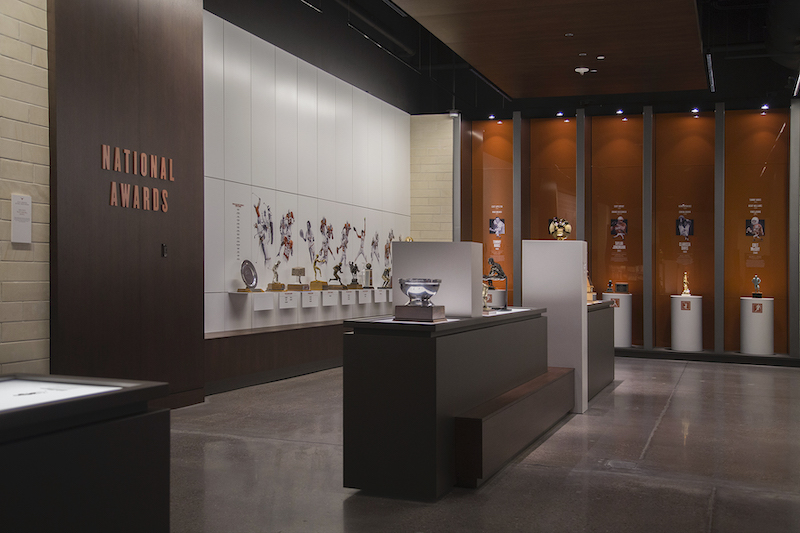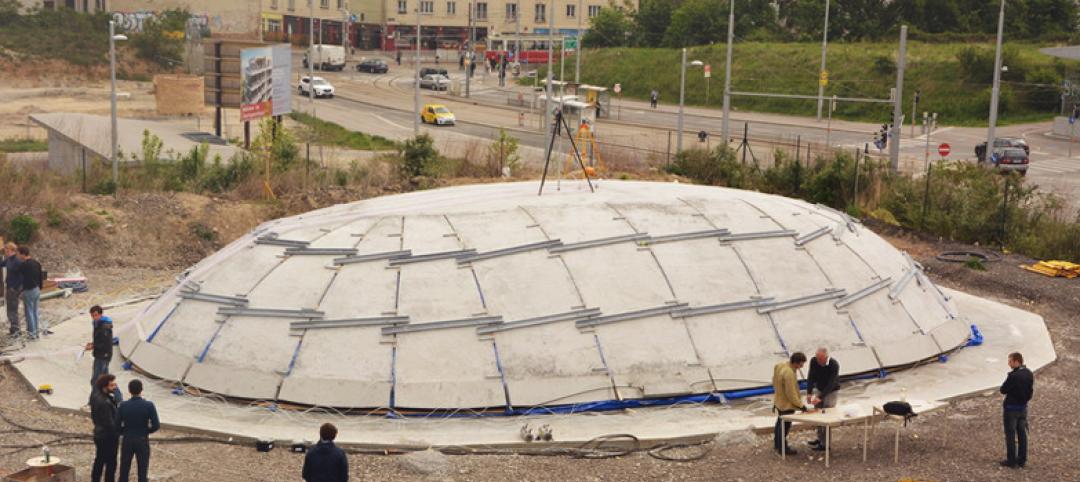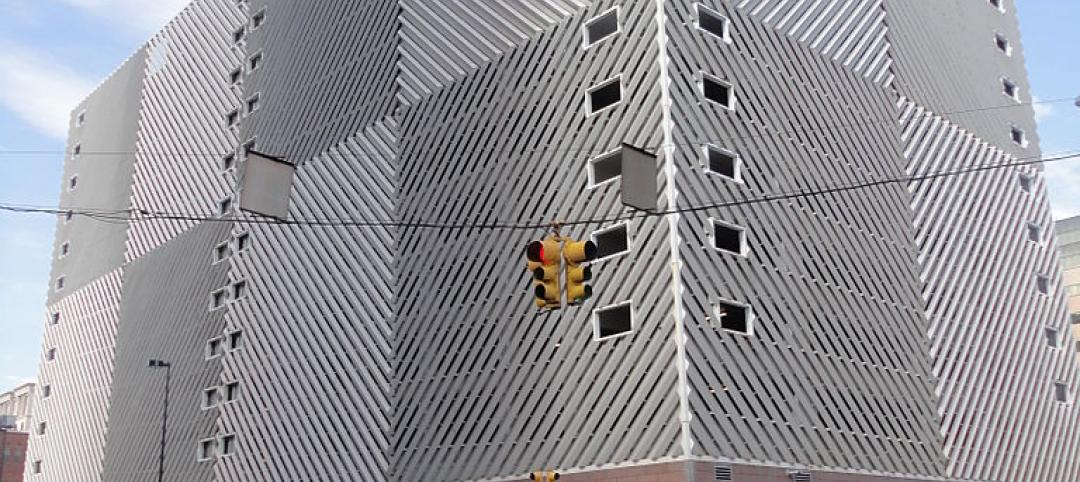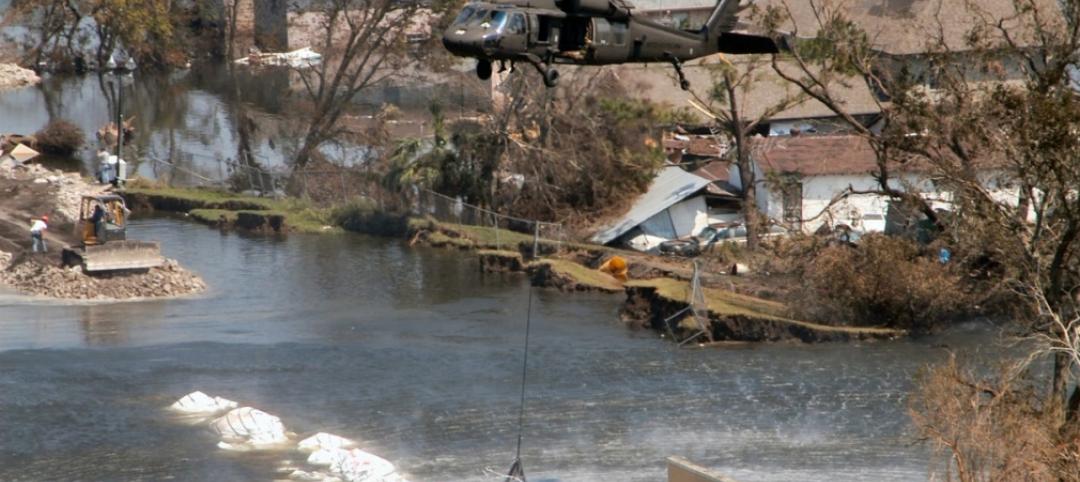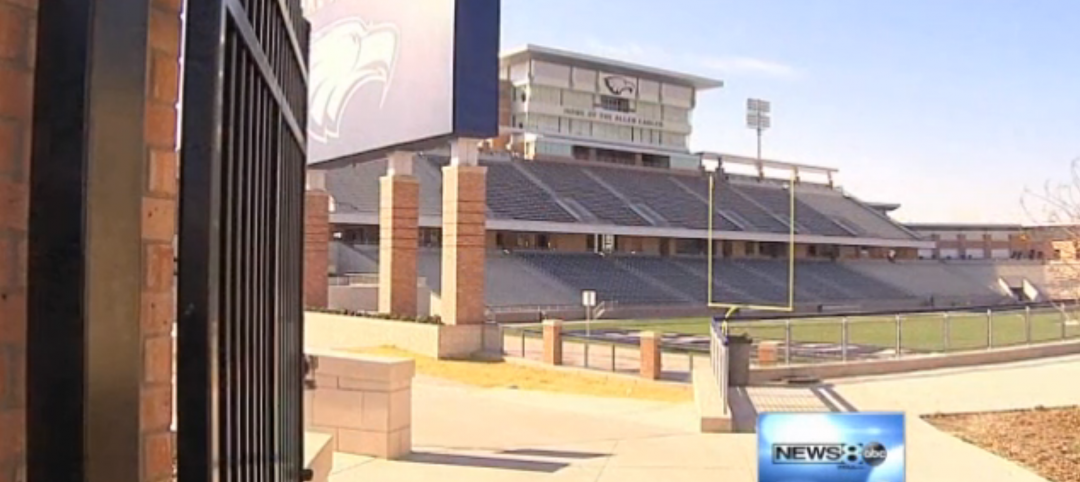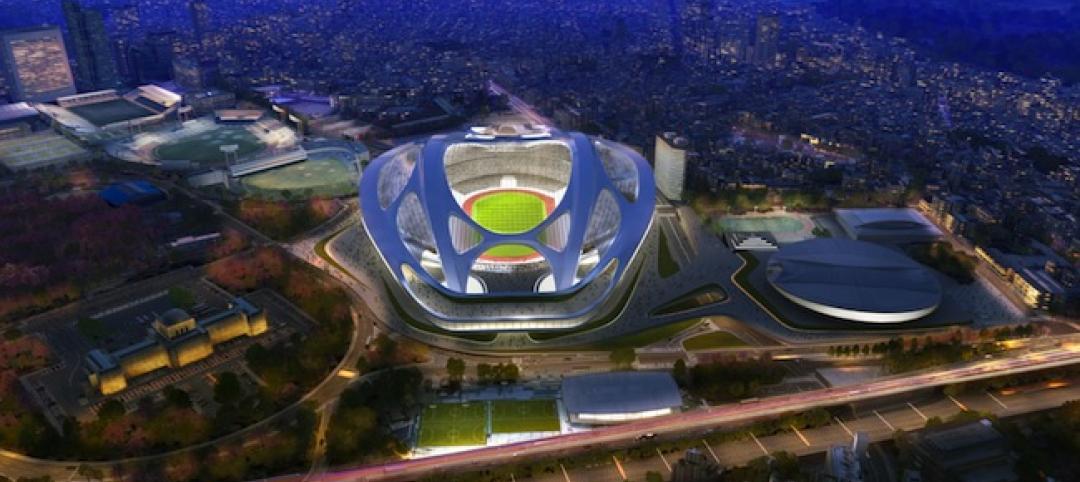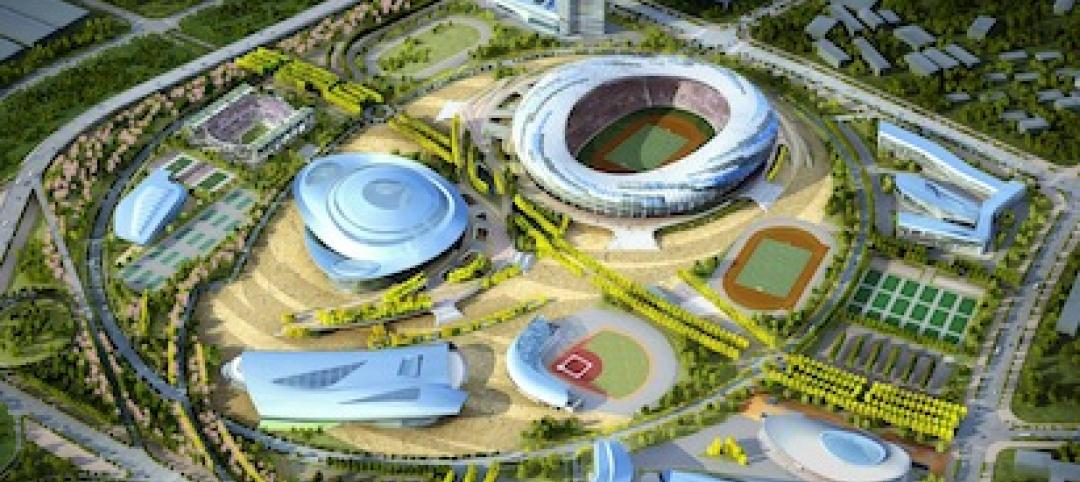Last Friday, the University of Texas at Austin held a grand opening ceremony for the Frank Denius Family Athletics Hall of Fame, a 24,713-sf space that is located at the north endzone of Darrell K. Royal-Texas Memorial Stadium.
The $17.1 million space, designed by Page and built by Turner Construction, includes 392 trophies earned over the decades by the university’s 20 sports teams. Visual and digital displays celebrate UT’s 55 national championship teams, 599 conference team titles, 144 individual national champions, and 171 Olympians who have won 145 medals.
The national champions are highlighted in their own 1,400-sf room with a 16x9-ft monitor that plays videos commemorating team title victories.
Also included in the Hall of Fame is an 8-ft-tall, 1,200-lb statue honoring the school’s mascot, the longhorn Bevo. The Hall of Fame offers a visual timeline of the 15 Bevos in Texas’ history since 1917.
Nashville, Tenn.-based Advent was a co-collaborator on this project, responsible for creating the “stories” that identify special touchstones and moments in the history of UT’s athletic programs.
John Roberson, Advent’s owner, had worked previously with Chris Del Conte, UT’s Athletic Director, when Del Conte held the same post at Texas Christian University. “Chris was brought in as a change agent, to restore the culture” for UT’s athletic program, Roberson tells BD+C.
That culture, he explains, is defined by stories “that are repeated.” Telling those stories required Advent to pull together the school’s trophies and other memorabilia that were scattered all over the place. For example, a Wheaties box that featured UT’s 2005 national championship football team and its legendary coach Mack Brown was found in someone’s garage. Trophies won by the school’s baseball team were located in crates in the basement of the team’s fieldhouse.
It’s not just the trophies that matter, though, says Roberson. “It’s identifying the heroes” and the narratives about individuals, teams, and special moments. Advent helped UT select those people and events using a proprietary process called “story mining,” which Roberson describes as “empathetic listening” to stakeholders. Advent used data analysis software to identify within those captured stories what needed to be told “to uncover the emotions” of the time and place.
“We’re transporting you, taking you back,” says Roberson, via images and interactive exhibits. “Memory is created by the experience that causes wonderment.”
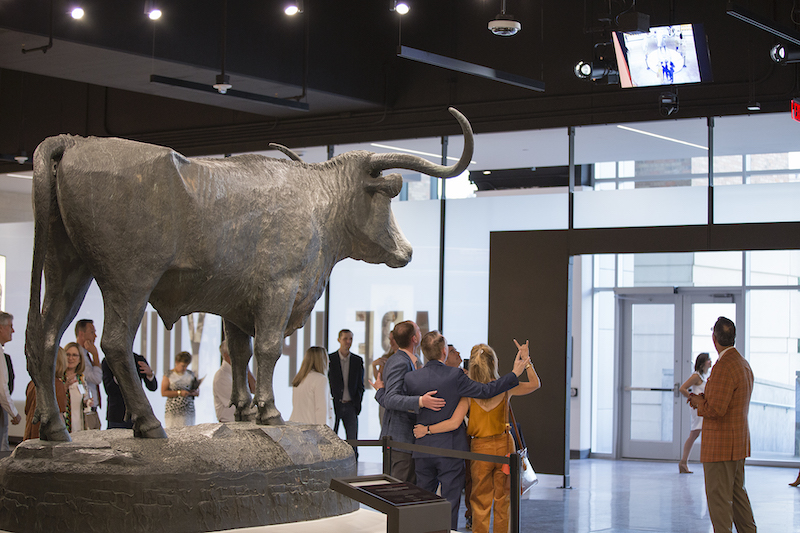
A statue of UT's mascot, the longhorn Bevo, is prominently displayed in the Hall of Fame. Image: Rick Myers/Advent
Darrell K. Royal-Texas Memorial is the ninth-largest stadium in the world, with a seating capacity of 100,119. So, says Roberson, several hundred thousand people could conceivably visit the Hall of Fame during the football team’s season, which opened with a 45-14 win over Louisiana Tech University last Saturday. Roberson expects UT to also use this facility as part of its student recruitment effort, and to lease it out for events like weddings.
He believes the Hall of Fame is a “smart investment” for the university to recapture a space that had been a wide concourse and circulation area with a modest food court.
In conjunction with the opening of the Hall of Fame, UT has entered into a joint branding agreement with the U.S. Olympic and Paralympic Committee in an effort to strengthen Olympic sports programming at the collegiate level. The tagline for the campaign is “Olympians Made Here.”
The Athletics Hall of Fame is named after Frank Denius, an alumnus who passed away in 2018 at the age of 93. Denius was a decorated World War II veteran, having been awarded four Silver Stars and two Purple Hearts. He earned two degrees, in business and law, at UT, and supported the university philanthropically.
Related Stories
| Jun 12, 2014
Austrian university develops 'inflatable' concrete dome method
Constructing a concrete dome is a costly process, but this may change soon. A team from the Vienna University of Technology has developed a method that allows concrete domes to form with the use of air and steel cables instead of expensive, timber supporting structures.
| Jun 11, 2014
Esri’s interactive guide to 2014 World Cup Stadiums
California-based Esri, a supplier of GIS software, created a nifty interactive map that gives viewers a satellite perspective of Brazil’s many new stadiums.
| Jun 4, 2014
Construction team named for Atlanta Braves ballpark
A joint venture between Barton Malow, Brasfield & Gorrie, Mortenson Construction, and New South Construction will build the Atlanta Braves ballpark, which is scheduled to open in early 2017. Check out the latest renderings of the plan.
| Jun 2, 2014
Parking structures group launches LEED-type program for parking garages
The Green Parking Council, an affiliate of the International Parking Institute, has launched the Green Garage Certification program, the parking industry equivalent of LEED certification.
| May 29, 2014
7 cost-effective ways to make U.S. infrastructure more resilient
Moving critical elements to higher ground and designing for longer lifespans are just some of the ways cities and governments can make infrastructure more resilient to natural disasters and climate change, writes Richard Cavallaro, President of Skanska USA Civil.
| May 22, 2014
Just two years after opening, $60 million high school stadium will close for repairs
The 18,000-seat Eagle Stadium in Allen, Texas, opened in 2012 to much fanfare. But cracks recently began to appear throughout the structure, causing to the school district to close the facility.
| May 20, 2014
Kinetic Architecture: New book explores innovations in active façades
The book, co-authored by Arup's Russell Fortmeyer, illustrates the various ways architects, consultants, and engineers approach energy and comfort by manipulating air, water, and light through the layers of passive and active building envelope systems.
| May 19, 2014
What can architects learn from nature’s 3.8 billion years of experience?
In a new report, HOK and Biomimicry 3.8 partnered to study how lessons from the temperate broadleaf forest biome, which houses many of the world’s largest population centers, can inform the design of the built environment.
| May 16, 2014
Toyo Ito leads petition to scrap Zaha Hadid's 2020 Olympic Stadium project
Ito and other Japanese architects cite excessive costs, massive size, and the project's potentially negative impact on surrounding public spaces as reasons for nixing Hadid's plan.
| May 13, 2014
First look: Nadel's $1.5 billion Dalian, China, Sports Center
In addition to five major sports venues, the Dalian Sports Center includes a 30-story, 440-room, 5-star Kempinski full-service hotel and conference center and a 40,500-square-meter athletes’ training facility and office building.


